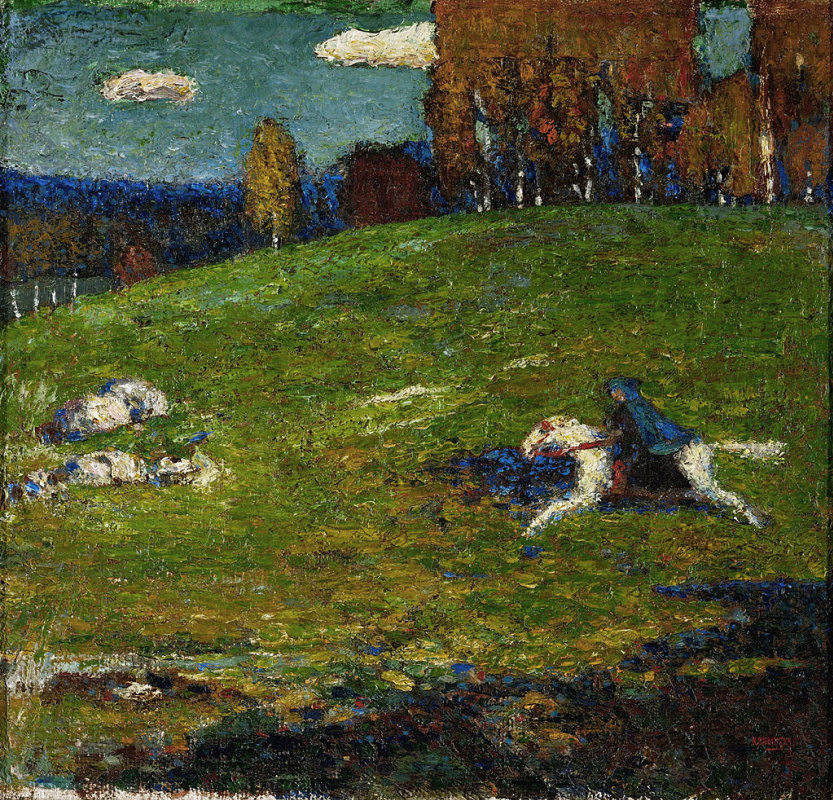log in
Enter site
Login to use Arthive functionality to the maximum
The blue rider
Wassily Kandinsky • Painting, 1903, 55×65 cm
Description of the artwork «The blue rider»
The Blue Rider, a small painting if compared with the artist’s later monumental canvases, was painted by Kandinsky at the very beginning of his career. We can say that this work is one of the most important and iconic not only for the early period of Kandinsky’s work, but also for his entire oeuvre. After all, it was this canvas that gave the name to the creative association created in 1911 by Wassily Kandinsky and Franz Marc. Having existed for only three years, the Blue Rider group managed to turn German painting traditions upside down and give way to fundamentally new forms of art.
Wassily Kandinsky never stated that the association was named after his painting. The artist only once admitted that the name was a tribute to both founders: “We both liked the blue colour. I liked riders, and Marc liked horses.” Indeed, riders have become subjects of his paintings (1, 2, 3, 4) as often as Franz Marc depicted blue horses (1, 2, 3). For the sake of these subjects, Kandinsky, even after his adhering to abstraction, returned to figurative painting from time to time, for example, in 1915, he depicted George the Victorious on a horse.
The Blue Rider painting became the first artwork by the artist, depicting a man on a horse. Although it was painted long before Kandinsky’s rejection of figurative painting, some art critics already see the prerequisites for the artist’s future style in it. The rider dressed in blue, who rides across the green meadow, is depicted as if offhandedly, his blurred figure and face do not allow guessing neither his gender nor age. The blurriness of the person’s outlines, together with the blurred background, creates a feeling of fast, impetuous movement, leaving no doubt that the rider is rushing towards his invisible goal at full speed. Some researchers put forward a version that the person is holding a baby. Following this theory, one can imagine a whole fascinating story, romantic or tragic, hidden behind the canvas.
Written by Yevgheniia Sidelnikova
Wassily Kandinsky never stated that the association was named after his painting. The artist only once admitted that the name was a tribute to both founders: “We both liked the blue colour. I liked riders, and Marc liked horses.” Indeed, riders have become subjects of his paintings (1, 2, 3, 4) as often as Franz Marc depicted blue horses (1, 2, 3). For the sake of these subjects, Kandinsky, even after his adhering to abstraction, returned to figurative painting from time to time, for example, in 1915, he depicted George the Victorious on a horse.
The Blue Rider painting became the first artwork by the artist, depicting a man on a horse. Although it was painted long before Kandinsky’s rejection of figurative painting, some art critics already see the prerequisites for the artist’s future style in it. The rider dressed in blue, who rides across the green meadow, is depicted as if offhandedly, his blurred figure and face do not allow guessing neither his gender nor age. The blurriness of the person’s outlines, together with the blurred background, creates a feeling of fast, impetuous movement, leaving no doubt that the rider is rushing towards his invisible goal at full speed. Some researchers put forward a version that the person is holding a baby. Following this theory, one can imagine a whole fascinating story, romantic or tragic, hidden behind the canvas.
Written by Yevgheniia Sidelnikova



